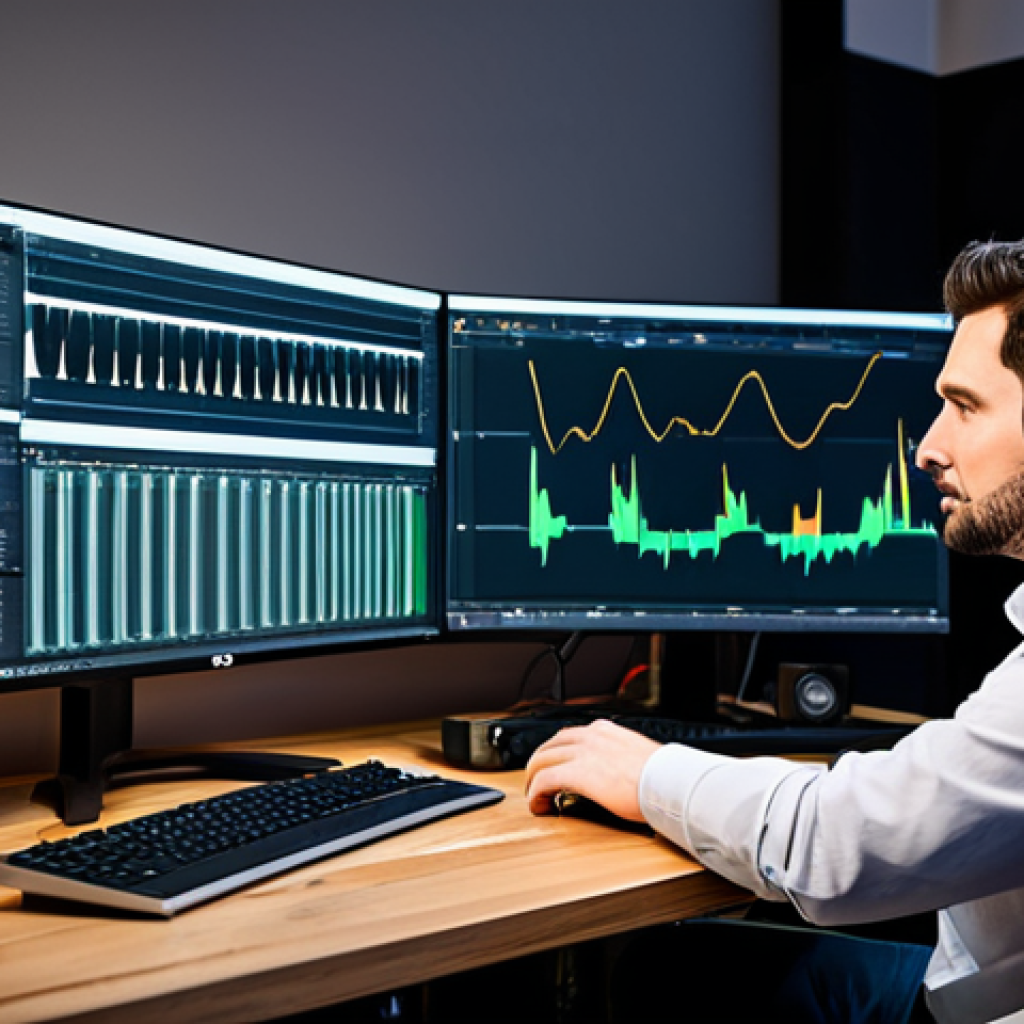Honestly, stepping into the vibrant world of multimedia content creation today feels like launching into orbit – incredibly exciting, but also a bit overwhelming with how fast things are moving.
I’ve personally witnessed how crucial it is to not just be creatively brilliant, but also technically savvy to truly cut through the noise. Think about it: from short-form video dominating platforms like TikTok and Instagram Reels, to the dizzying rise of AI tools that can generate anything from voiceovers to complex animations, the digital landscape is constantly shifting under our feet.
What felt cutting-edge yesterday might already be old news tomorrow. Staying ahead means mastering a dynamic blend of compelling storytelling, precise technical editing, and even a deep understanding of audience psychology.
It’s no longer just about pushing out content; it’s about crafting genuinely immersive experiences that resonate and adapt to the rapid-fire pace of digital consumption.
So, what truly makes a difference in this hyper-competitive and ever-evolving space, ensuring your creations aren’t just seen, but felt? Let’s truly understand what it takes.
Honing Your Core Technical Mastery

Stepping into the content creation arena, what I’ve personally found to be the absolute bedrock of success isn’t just a great idea, but the unflinching commitment to mastering the technical tools at your disposal.
This isn’t about being a certified expert in every single software; it’s about understanding the fundamentals so deeply that you can adapt to any new platform or update with relative ease.
I remember vividly when I first dipped my toes into video editing, feeling utterly overwhelmed by the sheer number of buttons and timelines in Adobe Premiere Pro.
But pushing through that initial discomfort, investing hours into tutorials, and even making countless terribly edited clips, was the most crucial step.
It wasn’t about perfection then, but about building muscle memory and an intuitive grasp of the software’s logic. This deep dive into the technical side transforms you from someone who *uses* tools into someone who *wields* them, capable of bringing intricate visions to life without being bottlenecked by technical limitations.
The magic happens when the technical becomes second nature, allowing your creative energy to flow unimpeded.
1. Video Editing Proficiency: Beyond the Cuts
It’s tempting to think of video editing as merely cutting clips together, but from my own journey, I can tell you it’s a storytelling art form in itself.
Beyond basic cuts and transitions, true proficiency lies in understanding pacing, rhythm, and how to evoke specific emotions through visual sequencing.
I’ve spent countless nights experimenting with jump cuts to create urgency, slow-motion to emphasize a moment, and color grading to set a mood. What truly elevates content is the subtle art of sound design – layering ambient noise, music, and voiceovers to create an immersive auditory experience.
It’s about knowing when to use a jarring sound effect for impact and when to let silence speak volumes. For instance, I once worked on a travel vlog where the initial edit felt flat; by simply adding the rustling of leaves and distant bird calls during a nature scene, and then transitioning to the muffled sounds of a bustling city, the viewer’s experience was transformed.
This isn’t just about making things look good; it’s about making them *feel* good, or impactful, or thought-provoking.
2. Audio Engineering Essentials: The Unsung Hero
If video is king, then audio is certainly the queen, and frankly, often the unsung hero. I’ve come across countless beautifully shot videos that were utterly ruined by poor audio quality – a tinny microphone, distracting background noise, or inconsistent volume levels.
My personal rule of thumb has always been: people will forgive mediocre visuals for excellent audio, but rarely the other way around. Investing in a decent microphone (even a simple USB one can be a game-changer) and understanding basic audio concepts like gain, noise reduction, and equalization is non-negotiable.
I remember early on, my voiceovers had an annoying hum; it was only after learning about applying a simple noise gate and EQ in post-production that my content started sounding genuinely professional.
It’s about ensuring clarity, warmth, and consistency, making your message not just heard, but comfortably listened to. This attention to detail dramatically increases dwell time, as viewers aren’t forced to strain or tune out distractions.
Crafting Compelling Narratives That Resonate
Once you’ve got the technical skills down, the real fun begins: telling stories that stick. I’ve personally experienced the profound difference between just presenting information and weaving a narrative that draws your audience in.
It’s not enough to simply state facts or showcase products; you need to connect on a human level. Think about your favorite content creators – they don’t just broadcast; they share their journeys, their struggles, their triumphs, and their unique perspectives.
This authenticity is the magnet that attracts and retains an audience. I often start my creative process by asking myself: “What’s the emotional core of this piece?” or “What feeling do I want to leave my audience with?” This approach forces you beyond superficial content and into creating something memorable.
The content world is oversaturated, and the only way to genuinely stand out is to be undeniably, unapologetically *you*, filtered through a captivating story.
1. The Art of the Hook: Grabbing Attention Instantly
In a world of endless scrolls, the first few seconds of your content are make-or-break. I’ve learned this the hard way, witnessing my audience retention drop off a cliff when I didn’t nail the opening.
The “hook” isn’t just a catchy phrase; it’s a promise, a question, or a visually arresting moment that compels viewers to stay. For a blog post, it might be a bold statement or a relatable anecdote, like the one I started this very post with.
For a video, it could be a quick highlight reel of the best moments, a perplexing problem posed, or an unexpected visual. I often experiment with different hooks during my editing process, testing which one evokes the most curiosity.
The goal is to create an immediate sense of intrigue, making the audience think, “I need to know what happens next” or “This person gets it.” It’s about setting the stage for what’s to come, subtly promising value without giving everything away.
2. Structuring for Engagement: Pacing and Flow
Once you have them hooked, keeping them engaged is the next hurdle. This is where pacing and flow become critical. I’ve found that even the most fascinating topic can fall flat if it’s delivered in a monotonous or disorganized way.
Think of your content like a roller coaster – you need ups and downs, moments of acceleration, and periods of reflection. For written content, this means breaking up long paragraphs with subheadings, bullet points, and even strategically placed tables or images to give the eye a rest and aid comprehension.
In video, it’s about varying shot types, cutting quickly during high-energy segments, and slowing down for more reflective moments. I meticulously review my content, often reading it aloud or watching it back multiple times, specifically looking for areas where my attention wanes.
If *my* attention drifts, chances are my audience’s will too. This iterative process of refinement ensures that your narrative unfolds naturally, holding attention from beginning to end.
Leveraging Analytics for Sustainable Growth
Creating content is one thing; understanding how it performs and using that data to grow is an entirely different, equally vital skill. I used to just post and hope for the best, but after a few years, I realized that wishful thinking doesn’t build an audience.
It was only when I started religiously diving into my analytics dashboards – Google Analytics for my blog, YouTube Studio for videos, and Instagram Insights for social media – that I truly began to see patterns and make informed decisions.
This isn’t about getting lost in a sea of numbers; it’s about identifying key performance indicators (KPIs) that tell you what’s working and what isn’t.
For me, it was a game-changer to realize that certain types of intros led to significantly higher watch times, or that articles with specific keywords outperformed others in search rankings.
It’s like having a direct line to your audience, telling you exactly what they want more of.
1. Understanding Audience Behavior: Beyond Page Views
While page views and subscriber counts are great vanity metrics, I’ve found that the real gold lies in understanding *how* people interact with your content.
For a blog, this means looking at dwell time, bounce rate, and scroll depth. Are readers actually finishing your articles, or are they leaving after the first paragraph?
For video, it’s all about audience retention graphs – where do people drop off? Is there a particular segment that consistently makes people leave? I remember a video where my retention plummeted around the 3-minute mark; upon review, I realized I had gone on a tangent that wasn’t relevant to the main topic.
Learning from that, I started tightening my scripts and editing more ruthlessly. This kind of deep dive into behavior helps you refine your content strategy, ensuring you’re delivering what your audience truly values, which in turn leads to higher engagement and better AdSense performance.
2. SEO & Keyword Strategy: Becoming Discoverable
Content is king, but discoverability is the crown. It pains me to see creators pour their heart and soul into amazing content only for it to get lost in the digital ether because they neglected basic SEO.
I’ve spent countless hours researching keywords, not just for volume but for *intent*. What are people actually searching for when they land on my content?
Using tools like Google Keyword Planner or Semrush, I look for long-tail keywords that my audience is actively using, and then naturally integrate them into my titles, headings, and body text.
But here’s the crucial part: it’s not about keyword stuffing. It’s about creating genuinely valuable content that answers those specific queries. My approach is always to write for humans first, then optimize for search engines.
This balance ensures that your content isn’t just found, but that it actually satisfies the user’s intent once they arrive, leading to lower bounce rates and increased authority in your niche.
| Content Metric | What It Tells You | Actionable Insight for Creators |
|---|---|---|
| Dwell Time / Average Session Duration | How long visitors stay on your page/content. High time indicates engagement. | Create more in-depth, engaging content. Use multimedia. Improve readability. |
| Bounce Rate | Percentage of visitors who leave after viewing only one page. High rate is bad. | Improve content relevance to title/meta-description. Faster page load. Clear calls-to-action. |
| Audience Retention (Video) | Percentage of video watched by viewers. Helps identify engaging/disengaging segments. | Analyze drop-off points to refine content structure, pacing, or remove weak sections. |
| Click-Through Rate (CTR) | Percentage of people who click on your content link from search results or social media. | Optimize titles, thumbnails, and meta-descriptions to be more compelling and relevant. |
| Conversions (e.g., Email Sign-ups) | How many visitors complete a desired action. | Refine calls-to-action, optimize landing pages, test different offers. |
Building Authority and Trust (E-E-A-T in Action)
In today’s content landscape, simply putting out information isn’t enough; you need to demonstrate why you’re the right person to deliver that information.
This is where the concept of E-E-A-T – Experience, Expertise, Authoritativeness, and Trustworthiness – truly comes into play. I’ve come to realize that my audience isn’t just looking for answers; they’re looking for answers from someone who has walked the walk.
This isn’t a theoretical concept; it’s about genuinely sharing your journey, showcasing your wins *and* your learnings from failures. I try to infuse my content with real-world examples from my own projects, client work, or even personal experiments.
For instance, when I talk about a specific video editing technique, I don’t just explain it; I talk about a time *I used it* and the specific outcome it achieved.
This level of transparency and lived experience builds an undeniable connection with your audience and establishes you as a credible voice.
1. Showcasing Real-World Experience
It’s one thing to read about a concept in a textbook or an online article; it’s another to hear someone explain how they applied it in a messy, real-world scenario.
I’ve made it a point to consistently share my direct experiences, whether it’s a specific challenge I faced during a live stream, a peculiar bug I encountered in a software, or a breakthrough I had after countless iterations.
For example, when discussing live streaming setups, I don’t just list equipment; I recount the time my internet cut out mid-stream and what backup strategies I’ve since implemented.
This isn’t just about showing off; it’s about providing practical, hard-won insights that only someone with genuine experience can offer. It adds a layer of authenticity that AI-generated content simply cannot replicate, building a bond of trust with your audience because they know you understand their struggles.
2. Cultivating Expertise and Authority
Expertise isn’t granted; it’s earned through consistent learning and application. I make it a priority to continuously deepen my knowledge in my niche, whether it’s by taking new courses, attending industry webinars, or simply dedicating time to dissecting successful content from others.
But expertise alone isn’t enough; you need to project authority. This means presenting your information clearly, confidently, and with conviction. It’s about being precise with your language, backing up your claims with evidence where possible, and not shying away from offering strong opinions when justified.
For instance, if I’m recommending a particular piece of software, I won’t just say “it’s good”; I’ll articulate *why* it’s good, based on my extensive use, comparing it to alternatives, and highlighting its specific advantages for different scenarios.
This level of detail and confidence reinforces your position as an authoritative voice in the field.
Monetization and Future-Proofing Your Content Business
Let’s be honest, while passion drives us, sustainability requires a strong understanding of how to monetize your efforts. I used to think monetization was just about throwing AdSense on my site, but I quickly learned it’s a multifaceted strategy that requires careful planning and optimization.
It’s about creating value that people are willing to pay for, whether directly or indirectly. And beyond immediate income, it’s about building a resilient content business that can adapt to changing trends and technologies.
I’ve always viewed my content as an asset, something that grows in value over time and opens doors to various income streams. This proactive approach to monetization isn’t just about financial gain; it’s about validating the immense effort you put into creating quality content and securing your ability to continue doing what you love.
1. Diversifying Income Streams: Beyond Ads
While AdSense is a foundational income stream for many, relying solely on it can be precarious. I’ve actively pursued diversifying my revenue, which has been crucial for stability.
This includes exploring affiliate marketing by recommending tools or products I genuinely use and believe in. It means looking into sponsored content partnerships, but only with brands that align perfectly with my values and audience’s interests – authenticity is key here, or you risk alienating your community.
I’ve also found success with digital products, like e-books or templates, which leverage my expertise into a scalable asset. The beauty of these diversified streams is that they create multiple safety nets, so if one channel has a dip, your entire livelihood isn’t jeopardized.
It also empowers you to create content for passion, knowing that multiple avenues support your work.
2. Adapting to Emerging Technologies and Trends
The digital landscape is a relentless current; standing still means falling behind. My personal strategy has always been to embrace emerging technologies rather than fear them.
When AI voiceovers and text-to-video tools first started gaining traction, I didn’t dismiss them; I experimented. I learned their limitations, discovered their strengths, and found ways to integrate them into my workflow to enhance efficiency without sacrificing the human touch.
The rise of short-form video on TikTok and Reels forced me to re-evaluate my content delivery, pushing me to condense complex ideas into digestible, high-impact clips.
This constant willingness to learn, adapt, and even *pioneer* new approaches is what ensures long-term relevance. It’s about staying curious, being agile, and understanding that the next big thing isn’t a threat, but an opportunity to innovate and connect with audiences in fresh, exciting ways.
Closing Thoughts
The journey of becoming a truly impactful content creator, one who not only captivates an audience but also sustains a thriving enterprise, is a deeply personal and continuous evolution.
It’s a masterful blend of honing your technical craft, perfecting the art of narrative, meticulously analyzing data, and, crucially, building a foundation of undeniable Experience, Expertise, Authority, and Trust.
What I’ve consistently found is that the most rewarding path isn’t about fleeting viral trends, but about a relentless commitment to genuine quality and authenticity.
It’s about connecting with your audience on a human level, one meticulously crafted piece of content at a time, and never stopping the pursuit of improvement.
Embrace the process, stay intensely curious, and let your unique voice resonate through every pixel and every word.
Helpful Resources
1. Continuous Learning Platforms: Never stop expanding your skillset! Websites like Coursera, Udemy, and Skillshare offer invaluable courses on everything from advanced video editing to nuanced digital marketing strategies. I’ve personally invested in several, and they’ve consistently paid dividends in both skills and confidence.
2. Community Engagement: Actively participate in creator communities on platforms such as Discord, Reddit (e.g., r/contentcreation, r/youtubers), or even local industry meetups. Sharing experiences, asking questions, and getting constructive feedback from peers can accelerate your growth immensely. Many of my breakthrough ideas have sparked from these collaborative interactions.
3. Advanced Analytics Tools: While native platform analytics (YouTube Studio, Google Analytics) are foundational, consider exploring third-party tools like Semrush or Ahrefs for deeper SEO insights, or TubeBuddy/VidIQ for YouTube-specific channel growth strategies. These tools offer a goldmine of data to refine your content strategy.
4. Content Calendar Planning: Utilize project management tools like Trello, Asana, Notion, or even a simple yet robust spreadsheet to meticulously plan your content strategy. Consistency is absolutely critical in content creation, and a well-organized calendar helps you maintain a steady output without succumbing to burnout.
5. Mental Wellness Resources: The demanding nature of the creator journey makes prioritizing your mental health non-negotiable. Resources like Headspace or Calm for mindfulness, or simply scheduling regular breaks and intentional digital detoxes, are crucial for long-term sustainability and maintaining creative vitality. Remember, you simply cannot pour from an empty cup.
Key Takeaways
Success in content creation hinges on a holistic, multifaceted approach. It’s about mastering your technical tools, particularly in video and audio, to eliminate any creative roadblocks, and then leveraging those polished skills to craft genuinely compelling narratives that captivate and resonate deeply with your audience. Crucially, sustainable growth stems from a deep dive into analytics, keenly understanding audience behavior, and optimizing for discoverability through a smart, human-centric SEO strategy. Finally, building undeniable E-E-A-T (Experience, Expertise, Authoritativeness, Trustworthiness) by consistently sharing your real-world journey, coupled with a proactive strategy for diversifying your income streams, are essential for future-proofing your content business and ensuring long-term impact and profitability in this ever-evolving digital landscape.
Frequently Asked Questions (FAQ) 📖
Q: With platforms like TikTok and
A: I tools evolving daily, how do content creators realistically keep pace without burning out? A1: Oh man, that’s the million-dollar question, isn’t it?
I swear, sometimes it feels like I’m trying to drink from a firehose! What I’ve personally found to be a game-changer isn’t trying to master every new shiny thing that pops up.
Seriously, you’ll just end up exhausted. Instead, it’s about building a solid foundation in the core principles – compelling storytelling, understanding your audience, and solid editing basics.
For instance, when Reels first blew up, I admit, I felt this intense pressure to crank out short-form video immediately. I tried to copy what everyone else was doing, and it felt forced, completely unauthentic.
It was only when I stepped back and asked, “How can my unique story or message fit into this format?” that things clicked. The AI tools? They’re incredible for efficiency, absolutely.
I’ve used them to speed up mundane tasks, like generating basic captions or even quick voiceover drafts, which frees up my brain for the really creative stuff.
It’s about leveraging them as assistants, not replacements for your unique human touch. Staying curious, experimenting with just one new tool or technique at a time, and never losing sight of why you’re creating in the first place – that’s the sustainable path, believe me.
Q: Beyond technical proficiency, what less tangible elements truly make a piece of multimedia content resonate deeply and feel genuinely immersive?
A: This is where the magic truly happens, in my opinion. Technical skills are your tools, but genuine resonance comes from the heart and head working together.
For me, it’s all about empathy. You have to really put yourself in your audience’s shoes. What are they feeling?
What questions do they have? What do they secretly yearn for? I remember working on a short documentary about local community initiatives, and initially, I was just focused on getting the shots right and the edits clean.
But the feedback was, “It’s good, but it doesn’t move me.” That hit me hard. I realized I hadn’t truly connected with the emotions of the people I was filming, or anticipated the emotional journey of the viewer.
So, I went back, reshot some interviews focusing on raw vulnerability, and deliberately crafted a narrative arc that mirrored a personal struggle and triumph.
It wasn’t just about showing what they did, but how it felt for them to do it. That small shift – focusing on the human experience, on authenticity, and a bit of emotional vulnerability in the storytelling – made all the difference.
It’s about tapping into universal truths and feelings, making people not just watch, but feel seen.
Q: In such a hyper-competitive digital space, what’s the secret to ensuring your content doesn’t just get seen, but truly cuts through the noise and isn’t forgotten tomorrow?
A: Ah, the age-old question of “how do I stand out?” It feels like shouting into a hurricane sometimes, right? From my own journey, the “secret” isn’t a single trick, it’s a blend of unwavering authenticity and relentless value.
Early on, I chased trends, trying to mimic what was popular, and honestly, it felt like I was constantly running on a hamster wheel, producing forgettable content.
It was utterly exhausting and completely ineffective. The real breakthrough came when I stopped trying to be everyone else and started leaning into my unique perspective and voice.
Think about it: what niche perspective do you bring? What problem do you uniquely solve, or what story can you tell in a way no one else can? For example, instead of just making another tutorial on video editing, I started sharing my frustrations with certain software quirks and my specific hacks for dealing with them – little things that resonated because they were real, they were my experience.
And then, it’s about consistency, not just in posting, but in delivering that specific brand of value or insight. People remember consistency, and they remember authenticity.
It’s about building a genuine connection with your audience over time, making them feel like they’re part of your journey, not just passive consumers.
That’s how you move from being seen to being truly felt and remembered.
📚 References
Wikipedia Encyclopedia
구글 검색 결과
구글 검색 결과
구글 검색 결과
구글 검색 결과
구글 검색 결과




